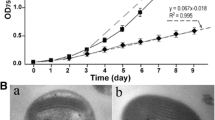Abstract
Chl a-containing, very small unicellular, eukaryotic phytoplankton (picophytoplankton) often become the dominant organisms near the bottom of the euphotic zone in the ocean, where light is limited, not only in intensity (about 0.5% of the surface irradiance), but also in quality (dominant in blue to green wavelengths). We have isolated picophytoplankton from subsurface waters (from 75 to 150 m in depth) of the Kuroshio area near Japan. EM observations showed that a single chloroplast occupies a large part of the cytoplasm. Some of the isolates have a flagellum. The major photosynthetic pigments found in these isolates were chlorophyll a and b. The light-harvesting chlorophyll a/b complex (LHCP) was isolated from three clones of picophytoplankton, one flagellated form (NIBB8001) and two coccoid forms (94B8100A and 94B5100C) . More than 50% of the total chlorophylls were recovered in the major LHCP fraction. A common feature of the major LHCPs isolated from the three picophytoplankton clones was a high abundance of chlorophyll b: the ratios of chlorophyll a to b were about 0.8, 0.7 and 0.6 for the clones NIBB8001, 94B8100A and 94B5100C, respectively. These values were very low compared with those in chlorophyll a/b-binding LHCIIs in higher plants and in the major chlorophyll a/b-binding LHCPs in microalgae (higher than 1.0). The major LHCP apoproteins of NIBB8001 and 94B5100C contained one major polypeptide; the apparent molecular masses analyzed with SDS-PAGE were about 22 kDa and 27 kDa, respectively. The major LHCP apoprotein of 94B8100A had two major polypeptides having apparent molecular masses of about 23 and 25 kDa. None of the thylakoid proteins cross-reacted with an antibody raised against the LHC IIα apoprotein of spinach. It is suggested that the high abundance of chlorophyll b in picophytoplankton, together with a large chloroplast in a small cell, enable them to utilize the reduced light in their habitat.
Similar content being viewed by others

References
Brown JS (1985) Three photosynthetic antenna porphyrins in a primitive green alga. Biochim Biophys Acta 807: 143-146
Castelfranco PA (1983) Chlorophyll biosynthesis: recent advances and areas of current interest. Ann Rev Plant Physiol 34: 241-278
Fawley MW, Stewart KD and Mattox KR (1986) The novel light-harvesting pigment—protein complex of Mantoniella wquamata(Chlorophyta): Phylogenetic implications. J Mol Evol 23: 168-176
Glover HE, Keller MD and Guillard RL (1986) Light quality and oceanic ultraphytoplankters. Nature 319: 142-143
Green BR and Durnford DG (1996) The chlorophyll-carotenoid proteins of oxygenic photosynthesis. Annu Rev Plant Physiol Plant Mol Biol 47: 685-714
Hiller RG, Anderson JM and Larkum AWD (1990) The chlorophyll-protein complexes of algae. In: Scheer H (ed) Chlorophylls, pp 5290-547. CRC Press, Boca Raton, FL
Ikeya T, Ohki K, Takahashi M and Fujita Y (1991) Photosynthetic pigment system of picophytoplankton of cyanophytes isolated from subsurface water in the Kuroshio area. J Oceanograph Soc Japan 47: 1-6
Jansson S (1994) The light-harvesting chlorophyll a/b-binding proteins. Biochimica Biophysica Acta 1184: 1-19
Kishino M, Okami N, Takahashi M and Ichimura S (1986) Light utilization efficiency and quantum yield of phytoplankton in a thermally stratified sea. Limnol Oceanogr 31: 557-66
Laemmli UK (1970) Cleavage of structural proteins during the assembly of the head of bacteriophage T4. Nature (London) 227: 680-685
Mackinney G (1941) Absorption of light by chlorophyll solutions. J Biol Chem 140: 315-322
Melis A, Murakami A, Nemson JA Aizawa K, Ohki K and Fujita Y. (1996) Chromatic regulation in Chlamydomonas reinhardtiialters photosystem stoichiometry and improves the quantum efficiency of photosynthesis. Photosynth Res 47: 253-265
Morel FMM, Rueter JG, Anderson DM and Guilard RR (1979) Aquil: a chemically defined phytoplankton culture medium for trace metal studies. J Phycol 15: 135-141
Pintner IJ and Provasoli L (1958) Artificial cultivation of redpigmented marine blue-green alga, Phormidium persicinum. J Gen Microbiol 18: 190-197
Shedbalker P and Rebeiz CA. (1992) Chloroplast biogenesis: determination of the molar extinction coefficients of divinyl chlorophyll aand band their pheophytins. Analyt Biochem 207: 261-266
Stockner JG (1988) Phototrophic picoplankton: an overview from marine and freshwater ecosystems. Limnol Oceanogr 33: 765-775
Stockner JG and Antia NJ (1986) Algal picoplankton from marine and freshwater ecosystems: A maltidisciplinary perspective. Can J Fish Aquat Sci 43: 2472-2503
Takahashi M and Hori T (1984) Abundance of picophytoplankton in the subsurface chlorophyll maximum layer in subtropical and tropical waters. Marine Biol 79: 177-186
Wilhelm C (1987) Purification and identification of chlorophyll c 1from the green alga Mantoniella squamata. Biochim Biophys Acta 892: 23-29
Author information
Authors and Affiliations
Rights and permissions
About this article
Cite this article
Ohki, K., Honjho, S. Oceanic picophytoplankton having a high abundance of chlorophyll b in the major light harvesting chlorophyll protein complex. Photosynthesis Research 53, 121–127 (1997). https://doi.org/10.1023/A:1005857903821
Issue Date:
DOI: https://doi.org/10.1023/A:1005857903821



